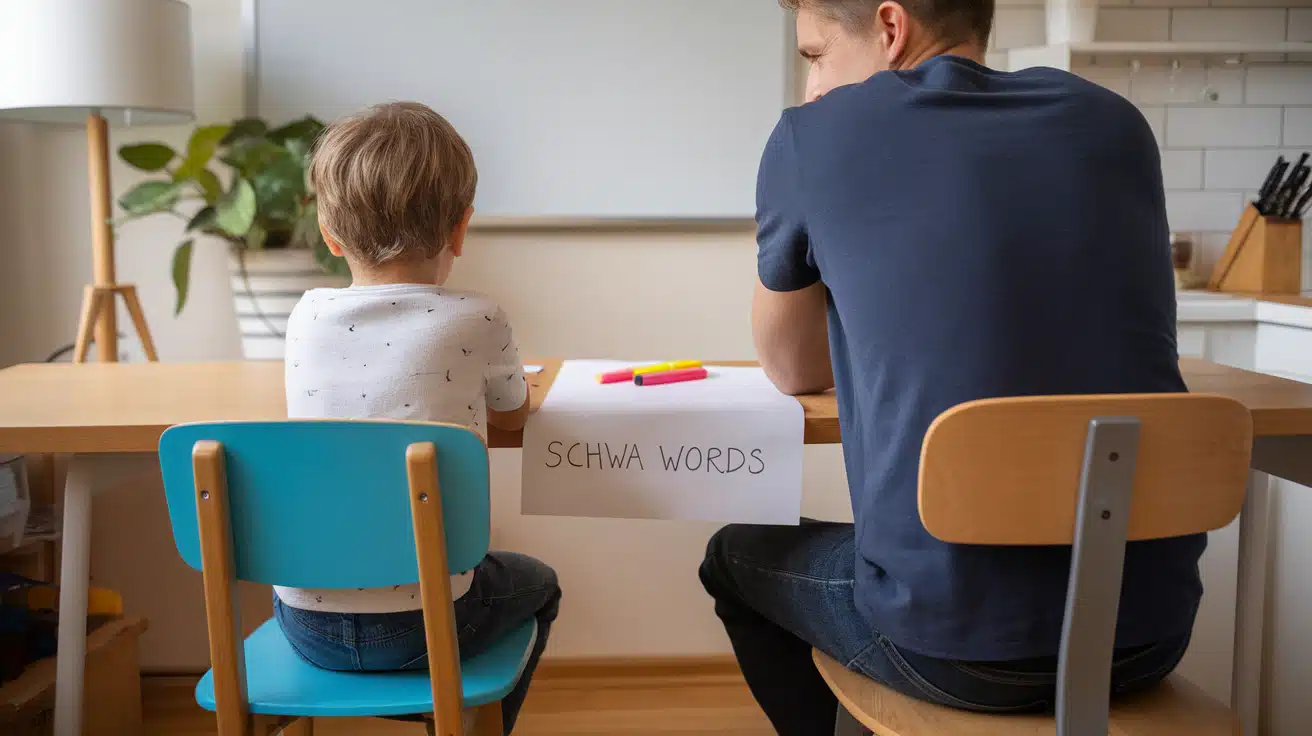I’m guessing you’ve said words like banana or sofa dozens of times without really thinking about the vowel sounds.
That soft little “uh” sound that seems to disappear into the background? That’s the schwa. I didn’t even notice it until someone pointed it out, and now I hear it everywhere.
In this post, you’ll get a clear and simple guide to words with the schwa sound—what they are, why they matter, and how to spot them.
Whether you’re teaching a student or learning for yourself, I’ve broken it all down in a way that makes it easy to follow and actually stick. Let’s make this simple together.
What Is the Schwa Sound?
The schwa is a neutral vowel sound that appears in many English words, particularly in unstressed syllables. It’s not tied to any one vowel letter and can be spelled with a, e, i, o, or u.
You’ll find it in words like banana, problem, and about. It’s a very quick, soft sound that replaces the expected vowel when the syllable isn’t stressed.
In dictionaries, it’s shown with an upside-down e symbol: /ə/. You use it all the time, often without realizing it.
What It Sounds Like
The schwa sounds like a very quick and quiet “uh” or a soft “i.” It’s the sound your mouth makes when you relax your jaw and speak without tension.
You don’t hold the vowel sound or shape it much, just a light touch of sound before moving to the next syllable.
You’ll hear it in the first and last syllables of banana or the middle of sofa and animal. Because it’s so light, it can be hard to hear unless you slow down the word.
Why It Matters in English
The schwa helps make English sound smooth and natural. Without it, words would feel choppy and awkward. Most multi-syllable words in English have at least one syllable that’s not stressed, and that’s often where the schwa shows up.
Learning to hear and use the schwa helps with reading, spelling, and pronunciation. It’s also a helpful clue when figuring out which syllables in a word are stressed and which are not.
For English learners and young readers, recognizing the schwa makes decoding and speaking easier.
How to Spot the Schwa Sound
You can find the schwa by listening for the soft, quick sound in unstressed syllables. It often replaces expected vowels in everyday words.
Common Patterns
The schwa appears in words where a vowel is present but not pronounced. It often shows up in prefixes, suffixes, or middle syllables.
For example, in support, the first syllable “sup” is unstressed and sounds like “suh.” In the problem, the second syllable “lem” becomes “luhm.”
You’ll also notice schwas in endings like -al, -en, and -ous (as in animal, golden, and famous). These patterns are common across age levels and reading stages, making them essential to learn early.
Word Position and Vowel Flexibility
Schwa can appear at the beginning, middle, or end of a word. It’s not picky about location. For instance, about starts with a schwa, sofa ends with one, and animal has it in the middle.
Also, any vowel letter, a, e, i, o, or u, can make the schwa sound depending on how the word is spoken.
This makes it tricky for spelling but useful for pronunciation. Since the sound stays the same regardless of the vowel used, you have to listen for stress, not just spelling.
Schwa Word List

Use these schwa word lists to help with reading, spelling, and pronunciation—syllable count and vowel lettering for easy practice, grouped by word.
One and Two-Syllable Words
Problem
Bottom
Blanket
Syringe
Lemon
Focus
Album
Pupil
Pencil
Button
Kitten
Rabbit
Jacket
Vinyl
Magic
Tinsel
Mitten
Supply
Tunnel
Bucket
Dinner
Rocket
Carpet
Sunset
Catfish
Bellman
Pitfall
Taken
Bacon
Label
Syrup
Pajama
Panda
Ballot
Gallon
Giraffe
Garage
Happen
Silent
Travel
Melody
Dragon
Dozen
Camel
Camelot
Cabin
Seven
Wagon
Pardon
Salmon
Cousin
Cancel
Radish
Satin
Tulip
Ribbon
Muffin
Reason
Moment
Person
Final
Naval
Legal
Metal
Normal
Total
Signal
Actual
Banana
Human
Analysis
Difficult
Parrot
Voluntary
Accident
Ability
America
Family
Canada
Chocolate
Relative
Capital
Operator
Political
Develop
President
Animalistic
Original
About
Around
Away
Again
Amount
Agree
Drama
Plaza
Arena
Eleven
Chicken
Garden
Season
Estimate
Celebrate
Together
Editor
Agenda
Civil
Captain
Limit
Tonic
Divide
Pilot
Symbol
Animal
Habit
Police
Student
Doctor
Memory
History
Color
Collector
Collage
Region
Campus
Support
Circus
Butter
Culture
Conduct
Cactus
Tuesday
Result
Custom
Abandon
Zebra
Opera
India
China
Cola
Nervous
Famous
Dangerous
Generous
Curious
Serious
Mysterious
Glorious
Fabulous
Victorious
Three and Four-Syllable Words
Words by Vowel A as Schwa
Words by Vowel E as Schwa
Words by Vowel I as Schwa
Words by Vowel O as Schwa
Words by Vowel U as Schwa
Words Ending in -a or -ous
Teaching the Schwa Sound

Teaching the schwa sound builds better reading fluency, spelling accuracy, and natural speech. It’s essential to help learners hear and use this unstressed vowel in everyday language.
Games and Activities
Games make learning the schwa sound fun and easy to remember. Here are a few playful ways to practice and reinforce the concept:
Word Sort: Let kids sort schwa and non-schwa words into groups to build sound awareness.
Schwa Hunt: Have children highlight schwa words in a short story or passage as they read.
Flashcard Flip: Use flashcards to review and identify words with the schwa sound quickly.
Clap the Syllables: Clap out syllables to help learners hear which parts of the word are unstressed.
Picture Match: Match schwa words to images for a visual twist on word recognition.
Board Game Play: Use schwa words in a homemade board game where players read or act out words.
These simple games help turn listening practice into hands-on fun. Try a few and see what sticks best with your learners.
Sentence Practice
Using complete sentences helps learners hear how the schwa sound fits into everyday speech. Simple lines, such as “He has a banana” or “I saw a zebra,” work well for repeated reading.
Highlighting unstressed syllables in these sentences allows students to focus on where the schwa sound appears.
Practicing sentences slowly, then speeding them up, trains learners to reduce the incorrect syllables.
Creating their sentences using common schwa words gives students ownership and a deeper understanding.
Classroom and Home Tools
Both classroom and home settings can support schwa learning with the right materials. Printable lists of schwa words grouped by vowel letter or syllable count offer structure.
Anchor charts with visuals, such as stress symbols and example words, serve as reminders for students. Word walls that include schwa words keep them visible and familiar.
Audio tools and short video clips are helpful for pronunciation, especially when paired with interactive worksheets.
At home, vowel mats and guided activities make it easy for parents to reinforce what’s taught in school.
How to Say Schwa Sound Words Naturally
To say the schwa sound clearly, relax your mouth and let the syllable come out softly. Don’t overthink it—the sound should feel easy and unstressed.
- Keep your mouth relaxed: Don’t tighten your lips or jaw. Let your mouth rest in a neutral position.
- Make a soft, quick sound: Say a gentle “uh” (like in sofa) or a light “i” (like in pencil).
- Avoid stressing the syllable: Say it quietly and quickly without putting any force on it.
- Lower your tongue: Let your tongue sit low and flat in your mouth—don’t push it up or back.
- Keep your lips still: You shouldn’t need to round or stretch your lips much at all.
- Say the full word normally: Don’t slow down or break it up. The schwa will naturally fall into place.
- Practice out loud: Try saying words like banana, problem, and sofa slowly at first, then in regular speech.
With a little practice, words with the schwa sound will start to feel smooth and automatic.
Common Mistakes to Avoid
Even with practice, it’s easy to mix up the schwa sound. Here are a few common slip-ups to watch for:
- Mixing up schwa and short vowels: Schwa sounds like a quick “uh,” not a full short vowel like in cat or bed.
- Trying to pronounce every vowel clearly: Not all vowels need to be strong; unstressed syllables often blur into a soft schwa.
- Guessing spelling based on sound alone: Since any vowel can make the schwa sound, spelling isn’t always a clear guide.
- Putting stress in the wrong place: Misplacing emphasis changes how the word sounds and can hide the schwa completely.
Focus on hearing the rhythm of words, not just the letters. That’s the real key to mastering schwa sounds.
Conclusion
Now that you’ve made it through, I’m betting schwa sound words feel a lot easier to spot and pronounce. You’ve learned what the schwa is, how it sounds, where it shows up, and how to practice or teach it.
I started noticing that soft “uh” sound everywhere once I knew what to listen for, and you probably will too. Whether you’re supporting a learner or reviewing for yourself, the tips and word lists here give you a strong foundation.
Keep practicing through games, sentence work, or everyday reading. And if you’re looking for clearer tools like this, take a look at my other posts. You’ll find simple guides to tricky sounds and reading skills you can actually use.




